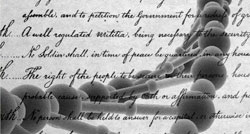By Dana M. Grimes, Esq.
 The late Justice Anton Scalia was in the minority of the momentous 5-4 opinion of Maryland v. King, (his scathing dissent was joined by justices Ginsberg, Sotomayor, and Kagan). He was correct pointing out the disingenuous reasoning in Justice Kennedy’s majority opinion. However, was Justice Scalia also correct in his conclusion Maryland v. King will result in vastly diminished protection of privacy of ordinary Americans?
The late Justice Anton Scalia was in the minority of the momentous 5-4 opinion of Maryland v. King, (his scathing dissent was joined by justices Ginsberg, Sotomayor, and Kagan). He was correct pointing out the disingenuous reasoning in Justice Kennedy’s majority opinion. However, was Justice Scalia also correct in his conclusion Maryland v. King will result in vastly diminished protection of privacy of ordinary Americans?
Alonzo King was arrested on assault charges in 2009. During the booking process in a county jail in Maryland, jail personnel, pursuant to the Maryland DNA Collection Act, took a cheek swab. King was convicted of the assault charges, but the issue was that the DNA swab taken during that booking in 2009 was found to match a DNA sample taken from the scene of crime committed in 2003, when a man concealing his face and armed with a gun broke into a woman’s home and raped her. The DNA tests showed that King’s DNA was at the crime scene, and King was convicted of the rape.
The Maryland Supreme Court found that the taking of the DNA swab in 2009 was a violation of King’s Fourth Amendment right to be free of unreasonable search and seizure. The U.S. Supreme Court overruled this decision, and upheld King’s conviction. For some strange reason, the majority opinion by Justice Kennedy elaborates at length the ways that the taking of King’s DNA in 2009 served the special purpose of “identifying” King in the assault arrest. As Scalia correctly points out, “nothing could be further from the truth.” King’s DNA sample was not received by the Maryland forensic science division until two weeks after King’s arrest. It then sat in that office, ripening in a storage area, until the custodians got around to mailing it to a lab for testing, two months after it was received. It was not until four months after King’s arrest that the sample transmitted from the Maryland DNA database to the FBI database was matched with a sample taken from the scene of the unrelated crime committed years earlier. Meanwhile, King was completely identified the day of his arrest, through the FBI’s Integrated Automated Fingerprint Identification System (IAFIS). The average response time for an electronic criminal fingerprint submission through IAFIS is 27 minutes, and the positive identification includes criminal history, mug shots, scars and tattoo photos, height, weight, race, hair color, and eye color.
The FBI’s DNA database, CODIS, is divided in two distinct collections. One of them consists of DNA samples from known convicts or arrestees. The other collection consists of samples taken from crime scenes – it is the “unsolved crime collection.” The CODIS system works by checking whether any of the samples of the unsolved crime collection match any of the samples of the convict and arrestee collection. This, of course, is what was done in King’s case, and it what Scalia believes to be a violation of King’s “privacy related concerns” protected by the Fourth Amendment, by an intrusion into the body, which is a suspicionless search.
Touching a cotton swab to the inside of the cheek of a person is not much of an “intrusion into the body,” and not much of an invasion of privacy to an arrestee who has already been detained, handcuffed, fingerprinted, photographed, and strip-searched, which happens on bookings for felonies, and even for misdemeanors where a suspect is booked instead of given a notice to appear. The majority found that the public policy benefits of allowing the taking of DNA samples from those arrested for “serious” crimes outweighs the minimal intrusion of privacy. The court did not define “serious.”
As to Justice Scalia’s prediction of the consequences of Maryland v. King: The consequences may be vast, in the sense that law enforcement agencies throughout the country will now be allowed to collect DNA samples from those arrested for “serious crimes,” and add those to the CODIS system, even if the arrest does not result in a conviction. Certainly this will be “scary” news for those who have left DNA at unsolved crime scenes. And Justice Scalia conceded that more crimes would be solved with the expanded CODIS data bank, which is a good thing. From time to time, the conviction of a defendant with DNA evidence results in the exoneration of another defendant who had been falsely accused of the same crime, and that is also a good thing.
Collecting the DNA of people who are arrested, not convicted – and therefore presumed innocent – is also scary for 4th Amendment purists, who worry DNA testing innocent people is not good precedent. After all, if we were all tested, even more DNA identifications would be made and more cold cases would be solved, but almost everyone agrees that would infringe the 4th Amendment. There are always ways that restricting freedoms will result in fewer crimes, but eroding the 4th Amendment is a frightening one. As a society, after all, we do allow thousands of preventable gun deaths per year, some of which are criminal, in the name of the 2nd Amendment.
It can be difficult to argue against the tangible good – “more solved crimes” – with the intangible concept – “freedom from unreasonable searches and seizures.” As H.L. Mencken put it, “The trouble with fighting for human freedom is that one spends most of one’s time defending scoundrels. For it is against scoundrels that oppressive laws are first aimed, and oppression must be stopped at the beginning if it is to be stopped at all.”